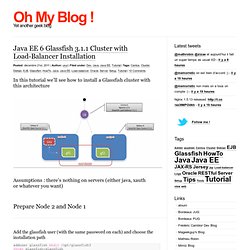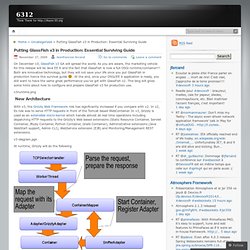

RESTful GlassFish Monitoring and Management. By Adam Bien Exploit the built-in monitoring and management capabilities of GlassFish to automate application deployment and gain insight into application performance.

Published December 2013 IT is all about streamlining and automation, so it is somewhat ironic that we developers still tolerate repetitive and boring manual tasks, such as deployment. Also, our ignorance about easily accessible information for application servers, such as monitoring data, is surprising. Application servers have emitted useful monitoring data and provided basic management capabilities for 10 years, ever since J2EE 1.4 was released in November of 2003.
This article describes the GlassFish management API, which allows you to manipulate the GlassFish application server's configuration, including its monitoring capabilities. The Forgotten Standard JSR 77 (J2EE Management) is a useful but forgotten standard. HTTP over JMX JMX is powerful, but Java is required in order to access JMX remotely. Figure 1. Listing 1. Building a Deployment Pipeline Using Git, Maven, Jenkins, and GlassFish (Part 1 of 2) Build an automated deployment pipeline for your Java EE applications using leading open-source technologies, including NetBeans, Git, Maven, JUnit, Jenkins, and GlassFish.

All source code for this post is available on GitHub. Introduction In my earlier post, Build a Continuous Deployment System with Maven, Hudson, WebLogic Server, and JUnit, I demonstrated a basic deployment pipeline using leading open-source technologies. In this post, we will demonstrate a similar pipeline, substituting Jenkins CI Server for Hudson, and Oracle’s GlassFish Application Server for WebLogic Server. We will use the same NetBeans Java EE ‘Hello World’ RESTful Web Service sample project. The three main goals of our deployment pipeline will be continuous integration, automated testing, and continuous deployment. Building a reliable deployment pipeline is complex and time-consuming. Maven is a powerful tool for managing modern software development projects. Requirements NetBeans IDE. Glassfish 3.1.1 Cluster with Load-Balancer Installation. Posted: décembre 21st, 2011 | Author: usul | Filed under: Dev, Java, Java EE, Tutorial | Tags: Centos, Cluster, Debian, EJB, Glassfish, HowTo, Java, Java EE, Load-balancer, Oracle, Server, Setup, Tutorial | 10 Comments In this tutorial we’ll see how to install a Glassfish cluster with this architecture Assumptions : there’s nothing on servers (either java, xauth or whatever you want) Prepare Node 2 and Node 1 Add the glassfish user (with the same password on each) and choose the installation path Add non-free in sources.list for sun jdk installation Install sun jdk Prepare LB Add the glassfish user (still with the same password) On Node 1 Install xauth The simpliest way is to install glassfish in graphical mode so we need xauth for x forwarding with ssh.

Logout and Log in with -X option. Glassfish install Download the GlassFish Server 3.1.1 Open Source Edition Full Platform. Optimize Glass Fish Performance.
Putting GlassFish v3 in Production: Essential Surviving Guide. On December 10, GlassFish v3 GA will spread the world.

As you are aware, the marketing vehicle for this release will be Java EE 6 and the fact that GlassFish is now a full OSGi runtime/container!!! Both are innovative technology, but they will not save your life once you put GlassFish in production hence this survival guide :-). At the end, once your OSGi/EE 6 application is ready, you still want to have the same great performance you’ve got with GlassFish v2. This blog will gives some hints about how to configure and prepare GlassFish v3 for production use. New Architecture With v3, the Grizzly Web Framework role has significantly increased if you compare with v2.
At runtime, Grizzly will do the following If you are familiar with Grizzly’s internals As you can see, it is critical to properly configure GlassFish in order to get the expected performance for your application and GlassFish in general. Debugging GlassFish Configuring the VM -Xmx512 -client and replace it with -XX:+UseCompressedOops. GlassFish v3 JDBC Resource. TIP: Glassfish v3 as Windows Service. The sun-web.xml File (Sun Java System Application Server Platform Edition 9 Application Deployment Guide) - Sun Microsystems. Context.xml jdbc/custom resource.